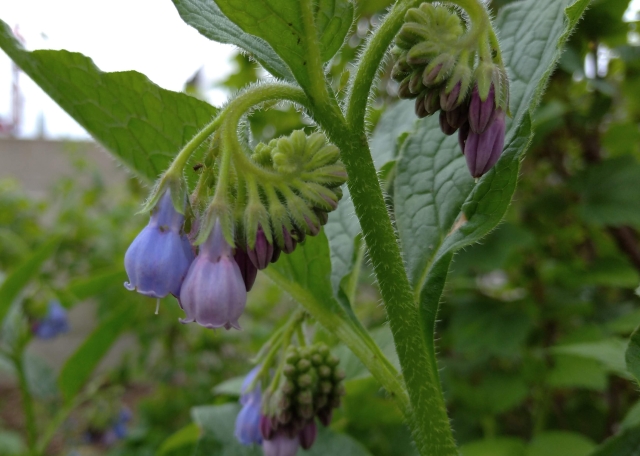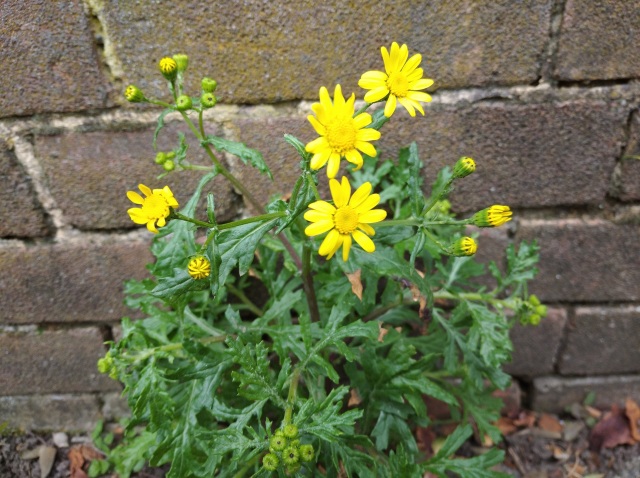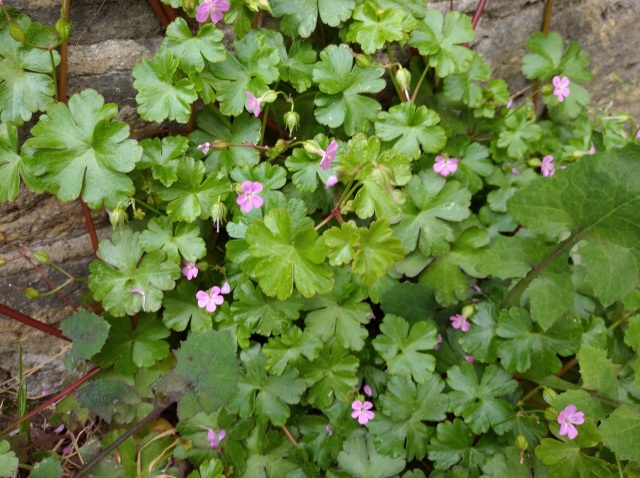
Comfrey 
Fumitory of the Wall 
Black Medick 
Garlic Mustard 
Oxford Ragwort 
Cuckooflower
What began as a wildflower awakening back in February has slowly blossomed into bit of an obsession. Now, I notice wildflowers wherever I go. More and more of them are becoming well known to me, usually just by their common names, but sometimes by their botanical ones too, so that I greet them as old friends as I go by. (Sometimes, I even know an interesting historical, ecological, etymological or culinary fact about them – or even, sometimes, a poem.) But there are still many new acquaintances to be made. A little window on a world previously unknown to me as suddenly, wondrously, swung open.
I think I know the reasons why. I get easily overwhelmed by stimuli and tend to experience a kind of tunnel vision when walking down a busy London street. When I worked in Central London I had to dodge a gauntlet of taxis, delivery lorries, shoppers, fellow workers, roadworks and chuggers to get from the tube to my office. No chance to spot and observe nature.

Ivy-leaved Toadflax 
Common Cat’s Ear 
Creeping Wood Sorrell 
Shining Cranesbill 
Jersey Cudweed 
Dove’s Foot Cranesbill
Nowadays, I have to navigate my way around wonky paving slabs, dog turds, fly tipping and broken glass, while calling to my young daughters not to dawdle or run too far ahead. The birds flit too quickly between the treetops for me to identify them, and even the trees, which tend to stay in one place, give me a dizzying dose of reverse vertigo as I squint up into their canopies in an attempt to discern their leaf shapes. But, like my children, wildflowers are small and close to the ground; I can keep an eye on one and an eye out for the other at the same time, without getting dizzy or disorientated.
On our eight-minute school run or 15-minute daily walk round the block, I might encounter patches of Jersey Cudweed, Creeping Wood Sorrell and Cornsalad livening up the paving cracks; clumps of Greater Celandine, Herb Bennett and Comfrey jostling for space in a tree pit; and crumbling front garden walls festooned with Ivy-leaved Toadflax and Black Medick.

Sowing dandelions 
Verge-ual safety 
Ramsons (wild garlic)
When we make it to a park, verge or green space away from a busy road, I can let down my guard a little. Here I might spend a happy few minutes deciding whether a flower that I would once have dimly mistaken for a Dandelion is in fact a Hawkweed or Cat’s Ear or else discover a new (to me) species of Violet or Speedwell, while my daughters equally happily sow dandelion seeds, make friends with a bee or construct a ‘nest’ from leaves and catkins. On a rare recent outing to the hairdresser without kids, I missed the bus while fawning over a bank of Buttercups and Cuckooflowers.
Admiring and identifying wildflowers is not without its perils. Each week I try to take part in the #WildflowerHour challenge on social media, which might be to spot and share a photo of a yellow wildflower, a wildflower growing on a wall or an invasive plant, for example. During the Tiny Geraniums challenge I spotted a patch of Shining Cranesbill in the corner of the school playground and managed to snap it just in time before the school gates shut on the three of us.
But as is often the case when I am just getting to know and love something new – I find it under threat. The very next day after our Shining Cranesbill escapade, the school caretaker meticulously cleared the playground edges of ‘weeds’ and I met a council worker uprooting the gutter weeds with a shovel on our road. The next day I noticed that some of the paving wildflowers had turned a suspicious shade of yellowy brown and acquired a pungent chemical odour.

Before weedkiller: Cornsalad 
After weedkiller: Cornsalad
I was hoping that my local park and verge wildflowers might escape the attack. This year, more and more gardeners and councils have been following the advice of Plantlife’s annual No Mow May campaign and putting their lawnmowers away for the month of May. Allowing lawns, verges and park meadows to grow wild during May provides a valuable source of nectar for struggling pollinators. Sadly, however, Haringey Council doesn’t seem to have got the memo. Yesterday, I was dismayed by the sight of my favourite wild verge needlessly reduced to lines of hay.
Luckily, wildflowers grow and spread their seeds quickly. Already, there are dandelions, sow thistles and patches of Groundsel, Shepherd’s Purse and Hairy Bittercress poking up through the paving cracks just feet away from their poisoned counterparts.
And luckily, I am not the only one noticing the wildflowers more. Plenty of my neighbours were similarly displeased by the recent mowing of our local wildflower verges. Perhaps, if we make our voices heard, next year will be a different story. In the meantime, I’m grateful that some people where I live have front lawns like this:

.
.


It’s rather lucky isn’t it that so many of our ‘weeds’ – native wildflowers – are able to survive. I’m glad to say our garden looks a lot like the last pic! We live in the country surrounded by fields – the buttercup have rather taken over this year 😊
LikeLiked by 1 person
Hi Clive, yes it’s lucky they are so hardy, I suppose that’s why they have a reputation as weeds! I’m envious of your garden – I hope to have something similar when we move to the countryside soon. I too am noticing more buttercups this year. I think there are 13 different varieties so identifying them is a bit of a challenge!
LikeLiked by 1 person
Hi Charlotte, I didn’t know there were that many! Our garden is fine in summer but in winter it reverts to the marshy field it once was 😐
LikeLiked by 1 person
Charlotte, I love your obsession! I wish I could name more than a handful as I adore finding them on our walks! Do you use a book or perhaps an app to identify them? Of course, your obsession will rub off to a greater or lesser extent, on your girls! 😊 What a joy to read this post. Maybe instead of trying to re-learn a language, I would be better off swatting up on wildflowers! Top marks to you and your girls” 🤩🤩🤩
LikeLiked by 1 person
Well, the most trusted book I use is a battered old Collins guide called The Wild Flowers of Britain and Northern Europe. As backup or if I’m completely stumped or out and about without the book I use a marvellous free app called iNaturalist. I also sometimes Tweet a photo of a wildflower using the hashtag #WildflowerID and an expert from the British Botanical Society of Britain & Ireland usually pops up fairly promptly with an ID.
There is so much to learn, but of course you can just enjoy them without knowing their names!
LikeLike
Hello Charlotte, this is such a lovely post! Out in the wilds of Suffolk I regularly wonder what I’m seeing growing in the hedges then forget to look them up. You’ve got 5 of them in your pictures! So thank you. We too suffer with yellow stripes of weedkiller every so often. But more and more places are leaving the wildness. The local church has a wild flower meadow thing going on and it is beautiful. Anyway, I’m following along with great interest… Best wishes, Jill xxx
LikeLiked by 1 person
Hi Jill, thanks so much for reading and I’m so glad I was of service! Enjoy your country walks, the church wildflower meadow sounds lovely!
LikeLike
Hi Charlotte – Jo from Seaford here. I too have discovered the joys of wildflowers but struggle with ID and have to photograph and then spend ages at home searching. I have several books, but none are easy to home in on the plant. The PlantSnap app is useless..In fact, Google Lens has been more reliable and has just helped me ID Yellow Rattle. Do you use an app? Have you discovered this wonderful site? bugwomanlondon.com. Slightly off subject, but do you know the ID of the old and very late into leaf trees along the Lordship Rec Model Traffic area. I asked a park worker but he had no idea..
LikeLiked by 1 person
Hi Jo, Thanks for reading. I find iNaturalist much better than PlantSnap. It’s easy to use and free. I use it for fungi too.
Yes, I follow that blog; it’s brilliant!
I’ve often wondered about those trees too. I’ll try to remember to take a picture next time we’re in the rec and send it to a tree expert I know called Paul Wood. He has written several books about trees in London https://thestreettree.com/
LikeLike